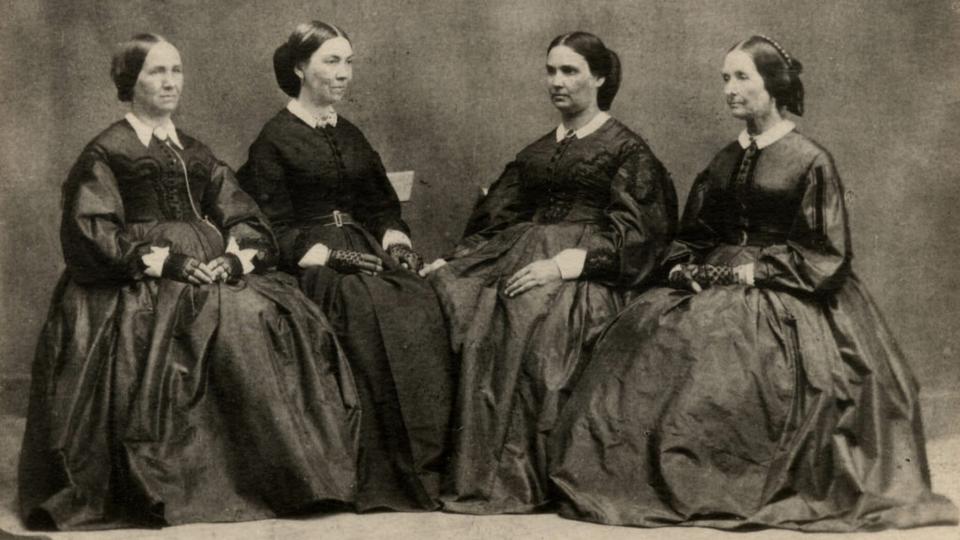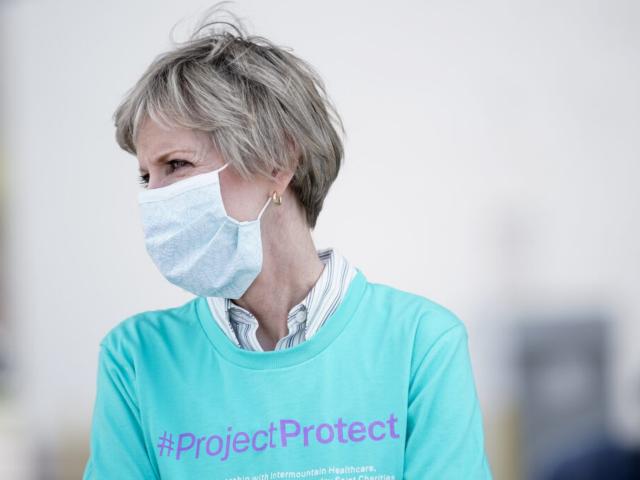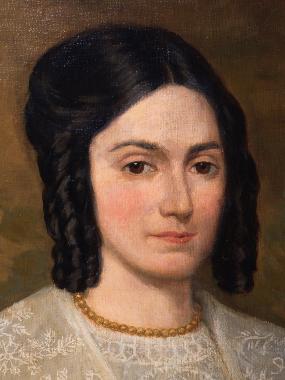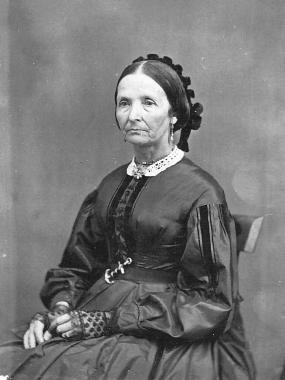This story appears here courtesy of TheChurchNews.com. It is not for use by other media.
By Jenny Reeder, Church History Department
On June 8, 1876, Eliza R. Snow visited Alpine, Utah. “This organization of the Relief Societies is a great thing,” she taught the congregation of men and women. “It is a strong power.”

Reeder
This portrait, titled “Leading Women of Zion” on the frame, was taken circa 1867 by Edward Martin. Left to right: Zina D. H. Young, Bathsheba W. Smith, Emily P. Young and Eliza R. Snow. 2021 by Intellectual Reserve, Inc. All rights reserved.I did not truly understand how the Relief Society is a force for good in the world until I both learned of its past and participated with women in the present. This comprehension happened simultaneously as I read, as I served, and as I received.
I felt the force for good when I worked the Tuesday evening shift in the Salt Lake City Temple for 18 months before it closed for reconstruction. I walked the same stairs, through the holy rooms where Zina Young and Bathsheba Smith acted as temple matrons at the same time they served as general Relief Society presidents. I knew where the portrait of Eliza R. Snow had hung, and where Emmeline B. Wells had a sacred encounter with the Savior.

Emmeline-B.-Wells-2
Portrait of Emmeline B. Wells taken January 14, 1879. Emmeline B. Wells traveled to Washington, D.C., in January 1879 to attend the annual convention of the National Woman Suffrage Association. In her diary entry of January 14, Wells noted, “This morn. went to Photo-gallery had pictures taken.” The photograph was taken at the Charles M. Bell studio in Washington. Photo courtesy of Church History Library.I also felt that force among the women with whom I served. We shared sacred bonds, literally connecting the past with the present with the future through the saving ordinances of the temple. And we deeply cared — and continue to care — for each other. We celebrated and mourned with each other. Even now, with the temple closed, we meet on Zoom and pray and laugh and cry together.
Generations of women have practiced holiness in diverse ways, times and places. They use the resources they have in their various situations. They seek the strength of their temple covenants. Their stories connect me to the women in my ministry and Relief Society today.
At this 179th anniversary of the organization of the Relief Society — March 17, 1842, in Nauvoo, Illinois — I, too, have experienced what makes this women’s association and its connection to the temple so strong. I love knowing that Emma Smith was the first woman both to receive her temple endowment in the Restoration and to help bestow it upon other women, and that she was the first Relief Society president in Nauvoo. The temple and the Relief Society are intricately connected.

Reeder
Sister Jean B. Bingham, Relief Society general president of The Church of Jesus Christ of Latter-day Saints, attends a collection drive for homemade clinical masks at the Deseret Industries in Ogden as part of the ProjectProtect initiative by Latter-day Saint Charities and local health care networks on Saturday, April 25, 2020. Photo by Spenser Heaps, courtesy of Church News.Copyright 2021 Deseret News Publishing Company.Women have gathered from the beginning, to care for the poor in body and in spirit. In a time of global pandemic, I loved seeing the Relief Society unite under the direction of Relief Society General President Jean B. Bingham to sew masks: three million in Brazil, 2,000 in French Polynesia, hundreds in Colombia, five million in Utah.
Upon visiting a sister to whom she ministered, my mother noticed her effort to sew masks on her old-fashioned treadle sewing machine. It was hard work — and my mom immediately took half of them home to help ease her sister’s burden. They were determined!
Sister Sharon Eubank, first counselor in the Relief Society general presidency, said, “Our name says Relief Society, and this is an opportunity where we can live up to that name and give relief.”

Emma-Smith
Emma Hale Smith, wife of the Prophet Joseph Smith, and the first president of the Relief Society. 2021 by Intellectual Reserve, Inc. All rights reserved.The mask effort reminds me of the grain storage program led by women in Utah Territory from 1876 to 1918. After the brethren failed to implement a plan to save food for a time of famine, Brigham Young called Emmeline B. Wells to manage the endeavor. With the assistance of Eliza R. Snow and others, Emmeline coordinated Relief Society efforts in each ward and branch, and local women researched, planned, built secure storage facilities and either purchased or gleaned grain. Eliza traveled to various branches and encouraged them. The sisters learned about the grain market as they acted according to their divine charge. When Emmeline served as general Relief Society president, that grain was transferred to needy Americans during World War I.
Many today gather virtually as Relief Society sisters. We see faces pop up, filling the screen, and we recognize dear friends. My home office has become a holy place as I listen to my sisters teach and testify on my computer screen. Eliza attended a stake Relief Society conference in Ogden, Utah, on Oct. 30, 1877, and taught the sisters that “union is strength.” If all the women would unite their energy, faith, and prayers, she said, they could “accomplish much.” Sometimes, accomplishing much just means being together. “If we have each a little of the right spirit and come together, it is like putting coals of fire together,” Eliza told a Salt Lake City Relief Society in 1872. “When they are separate, they cannot burn and soon go out, but when they are put together soon burst out in a blaze.”
I remember a time when I struggled with heavy health issues while living far away from family. One afternoon, one of my Relief Society sisters, Marian Anderson, visited me. We sat together on my stairs, where she put her arm around me, leaned her head in and cried with me. It was just enough to rekindle my spark. At a time of great distress, Emmeline recorded in her diary on Aug. 31, 1887 how refreshing it was to go to Relief Society and find companionship. Emmeline wrote often about the “satisfaction” she felt with her sisters. She often traveled with Eliza from Church headquarters in Salt Lake City to extend the flame in small gatherings in small settlements. Eliza captured this idea in Gunnison, Utah, as she encouraged the women “to become as anciently, holy women of God; to influence society, to elevate it, to give it a tone.” She continued, “If you want to be happy, come to your [Relief Society] meetings.”

Reeder
Photograph of Eliza R. Snow by Edward Martin. 2021 Intellectual Reserve, Inc. All Rights Reserved.I will. I will tune into that energy when I log into my Zoom account and beyond as I contribute to my community and my band of sisters. When I minister, when I send a little bit of my flame through a text or a card in the mail, I, too, am warmed. And together we will establish holy homes, shelters from life’s storms, and provide for each other.
The Church Historian’s Press today, March 16, announced the online publication of 141 additional discourses by Eliza R. Snow, dating from June 1875 to December 1877, and three years of diaries by Emmeline B. Wells, 1889 to 1891. These, along with additional Eliza discourses and Emmeline diaries, are available for free to the public at https://www.churchhistorianspress.org.
— Jenny Reeder is a women’s history specialist for the Church History Department.
Copyright 2021 Deseret News Publishing Company

